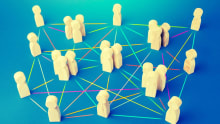How to create a future-ready organisational culture: Conference insights

The future of work is, at the moment, appearing to be the hybrid workplace model. But it extends well beyond that: besides the demand for a flexible working environment, there is the ongoing focus on talent as a source of competitive advantage, the need for a greater foundation of trust between stakeholders, and the need for collaboration between an organisation's various functions.
Winding through all these is the common thread of culture. How can an organisation's culture be made future-ready, capable of supporting and enabling all the different aspects of tomorrow's workplace? People Matters picked up a few pointers at Barco's Future-Ready Workplace virtual conference earlier this week.
Align senior management's beliefs and behaviour
The support and behaviour of an organisation's leadership shapes its culture even more comprehensively than policies or technology, said speakers.
“The empathetic support of senior management is an area that really needs to evolve,” observed Simon Piff, Vice President, Practice Lead, Future of Work, IDC Asia Pacific. Giving the conference's keynote from Singapore, where he is based, he pointed out that in hiring and retaining talent, creating trust is central—not just in terms of security, but in terms of the relationship that the organisation creates with its customers, its partners, and especially its employees.
“What we've seen is a hierarchical leadership and rigid organisation that needs to be more flexible and deliver more empathy than perhaps it has done in the past,” he said. “I know not everybody in Asia Pacific is going to agree with me: we've seen examples here in Singapore and across other markets where the hierarchical decision-making framework has worked, but at what cost of employee satisfaction? That's something to think about moving forward.”
Sylvain Newton, founder of Munich-based Newton Consulting, suggested that leaders can start by taking a more inclusive approach as they design the future workplace. “Do it together with your employees,” he said.
“Find out what their needs are, where they stand, do it in a way that drives productivity and engagement, and take forward that dialogue with your employees to find a model that fits both your strategy and your culture.”
Offer a sense of comfort and belonging
Throughout the discussions, speakers repeatedly touched on the need to make employees feel welcome in their workplace—whether through the design of the physical environment, the policies and processes that govern how work is done, the technological tools made available, or less tangible aspects such as a shared purpose.
Ambroise d'Hauteville, Director of Education at Steelcase APAC, pointed out that for employees to do their best at work, they need to feel a sense of comfort and belonging. He listed three types of comfort: physical, emotional, and cognitive, that play a role in making an organisation attractive to talent.
“When we think about attracting talent, in addition to comfort is belonging,” he said. “Belonging includes trust, inclusion, and shared purpose. For employees, trust is how I can deliver, as an employee, the best at work.”
The physical office environment will play a role here, he suggested. Citing Steelcase's research, he said that if people are spending large amounts of time away from the office, that physical environment will have to be redesigned to better enable work and learning during the time when they are actually in it.
Feeling welcome and comfortable is also about feeling that the organisation is conducive to their growth and development, said Marc Remond, Vice President, Meeting and Learning Experience, Barco APAC. As an example, he pointed out how the onboarding and orientation experience—the first 'welcome aboard', so to speak—can directly affect talent retention.
“The first 100 days in an organisation leave a big impression on the talent,” he said. “Human resources professionals are looking at new technology to improve the onboarding experience, make sure those talents are integrated and feel socially connected with new and older employees. At the end of the day, if that onboarding and learning experience is good, they're most likely to stay in an organisation for the long term."
"I think any employee is looking for an organisation who is always ready to invest in people, to make sure they grow personally, professionally, and even financially.”
Create an environment that aligns with learning
Upskilling and reskilling has become a new normal in the last year and a half, as organisations turn to internal training to fill skill gaps. A future-ready workplace and organisational culture, said speakers, is one that aligns with the development of digital—and other necessary—skills.
“It is about understanding the skills that an individual is using today in their work, understanding the skills that they brought with them from their previous environment that we perhaps have never tapped into,” said IDC's Simon Piff. “And really getting down to the heart of what a person can bring to an organisation, should they be sufficiently motivated, and then enabling them to level up, move on to the next stage in their career, and learn more in the process."
"By so doing, we will create a far more loyal and structured organisation that helps drive innovation, and innovation helps drive productivity and business success.”
The strategic use of technology to enable new skill sets and continuous learning also plays a role, according to speakers. Peter Liu, Talent and Organisational Development Manager at Barco APAC, observed that to encourage learning, organisations need to put learning right at the point of employee need. “In today's multi-generational, multi-cultural workplace, workforce diversity has made the one-size-fits-all approach a thing of the past,” he said.
Ultimately, speakers said, enabling a future-ready work culture is about making it easy and efficient for employees to demonstrate the behaviours that align with the driving factors of business success.
“The organisation wants to foster the right kind of responsibilities, roles and work style within the workforce,” commented Barco's Marc Remond. “That really is important because the workforce is the source of innovation and collaboration in any organisation.”















